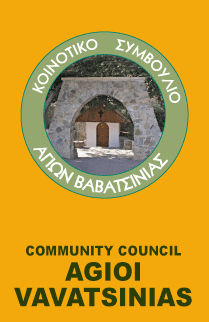Church of Ayioi (Saints) Anargiroi in Agious Vavatsinias
According to tradition, the village Agii Vavatsinias was visited by the thaumaturge Agii (Saints) Anargiroi. The church built in the 19th church, a tree known as “sxoinia ton Agion” (Saint’s rope) and the Saint’s holy water are all proof of the Saints’ passing.
The church of Agii Anargiroi, Kosmas and Damianos, is built in the centre of the village where an old church used to be. The church was built in 1871 on the base of an old church, which was built in the 16th century. The new church, which is extant until today, was dedicated to the two Saints at the end of the 19th century, in specific in 1893.
The church at Agious Vavatsinias is divided into three narrow and long parts and, like many of the houses in the area, it is built on a bed of rock particular to the area, adding to the church’s picturesque features. The roof of the church, which had to be repaired, is dome-shaped and covered with tiles. The belfry was badly built and was almost dismantled but thanks to a donation, it was repaired. The belfry was fully repaired in 1968.
Internally, the church is impressive. The graven iconostasis is decorated with icons that impress with their vivid colours. This unique iconostasis was engraved by the craftsman “Mihail ex Idaliou” (Michael from Idaliou). The church is also decorated with wonderful frescoes.
Next to the sanctuary’s entrance, there is a fresco depicting Saint George while on the inside walls of the sanctuary there is a fresco depicting Abrahams sacrifice. Unfortunately, this fresco is partly destroyed because the wall it is painting on had undergone corrosion.
According to the village’s priest, some of the icons, which were recently discovered, probably belong to the 16th century or even to previous centuries. These icons, according to the village’s priest, were buried next to the church for centuries and were found after the priest’s initiation.
The excavation to find the icons was based on an ancient oral story. For years, priests had reported stories on the church’s building. By the time the new church was built, the foundations of the old church were gradually dismantled. As a result, by the time the old church was completely demolished whatever remained inside it was left exposed and was finally buried in the parvis of the new church. The village’s priest based on the statements of other priests started excavating and came across the icons. These icons, which probably belong to the 16th century, will be maintained by the appropriate services after the village’s priest suggestions.
An Italian chair, created during the 16th century is very impressive but is in dander of being destroyed because no one has preserved it, despite its historical value.
From the above, one comes to the realisation that the Agii Anargiroi church is an important cultural monument which must be preserved for a number of reasons. The church is already under the auspices of the Department of Antiquities as a category B monument.
In conclusion, the story of the passing of Agii Anargiroi, Kosmas and Damianos is kept alive due to not only the church’s existence, the holy water and “sxoinia” but also due to the inhabitants’ narrations. What is important to note, is the fact that most inhabitants have had some kind of personal experience related to the Saints thaumaturgy. It is necessary to preserve all the abovementioned monuments so that future generations will know about the culture of their village.
Sources:
“Mass and benedictive canon of Saints Anargiron Kosmas and Damianos”, Agii Vavatsinias, 1999, edition House of God Agion Anargiron
Giorgou and Mahis Karouzi, “Agii Vavatsinias”, Journey to Cyprus, vol. 3, Nicosia, 1983 p. 107-110
George Karouzis and Christina G. Karouzis, Touring Guide of Larnaka, Nicosia, 1993
Priest of Agii Anargiroi Church, Papageorgios Papakyriakou
Head of community Agion Vavatsinias, Kyriakos Papakyriakou
|
